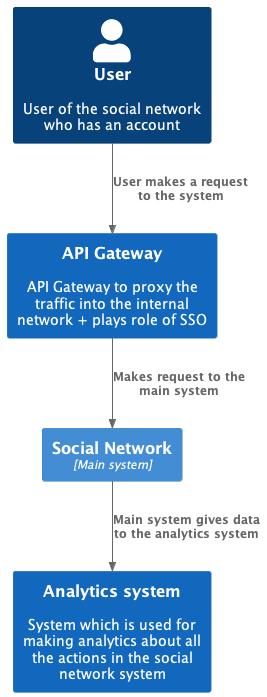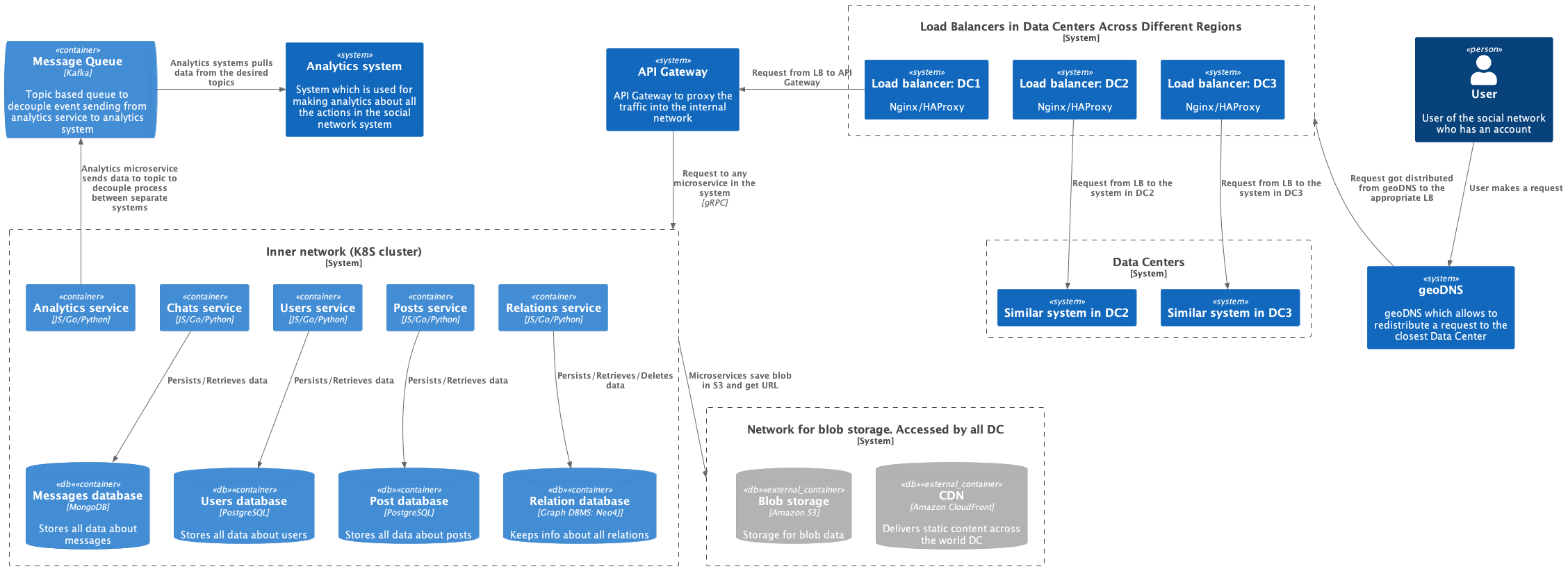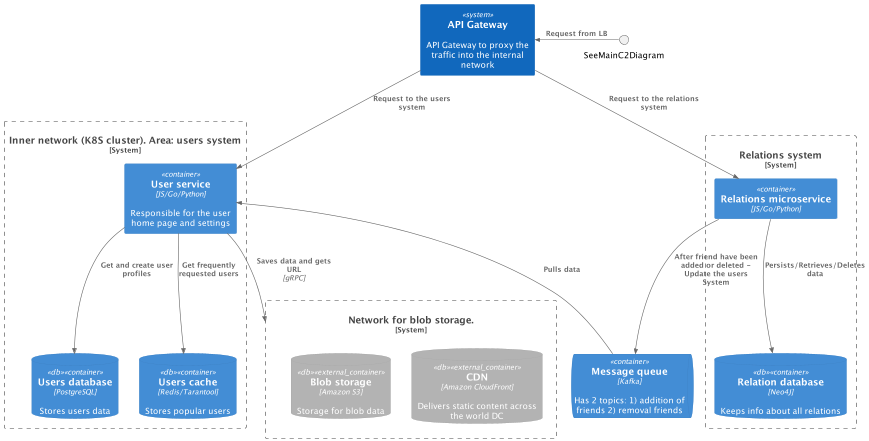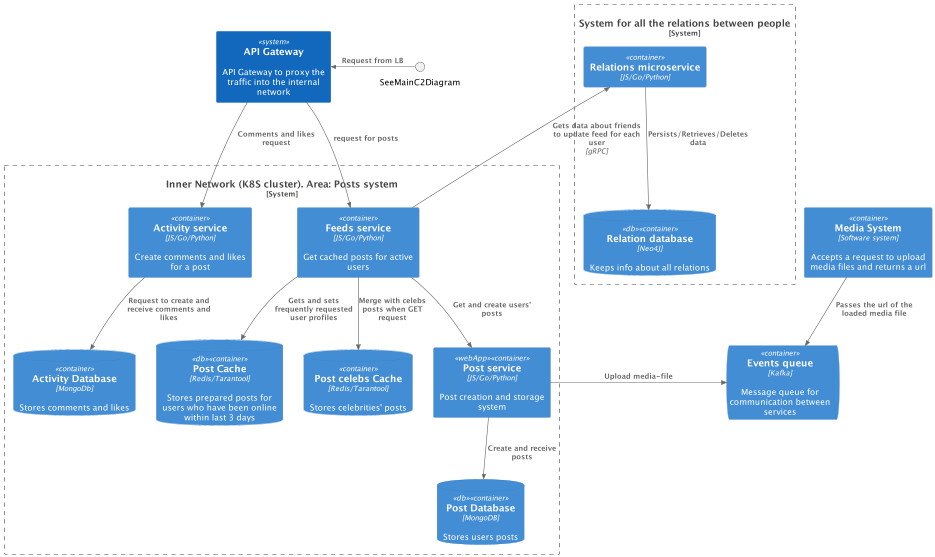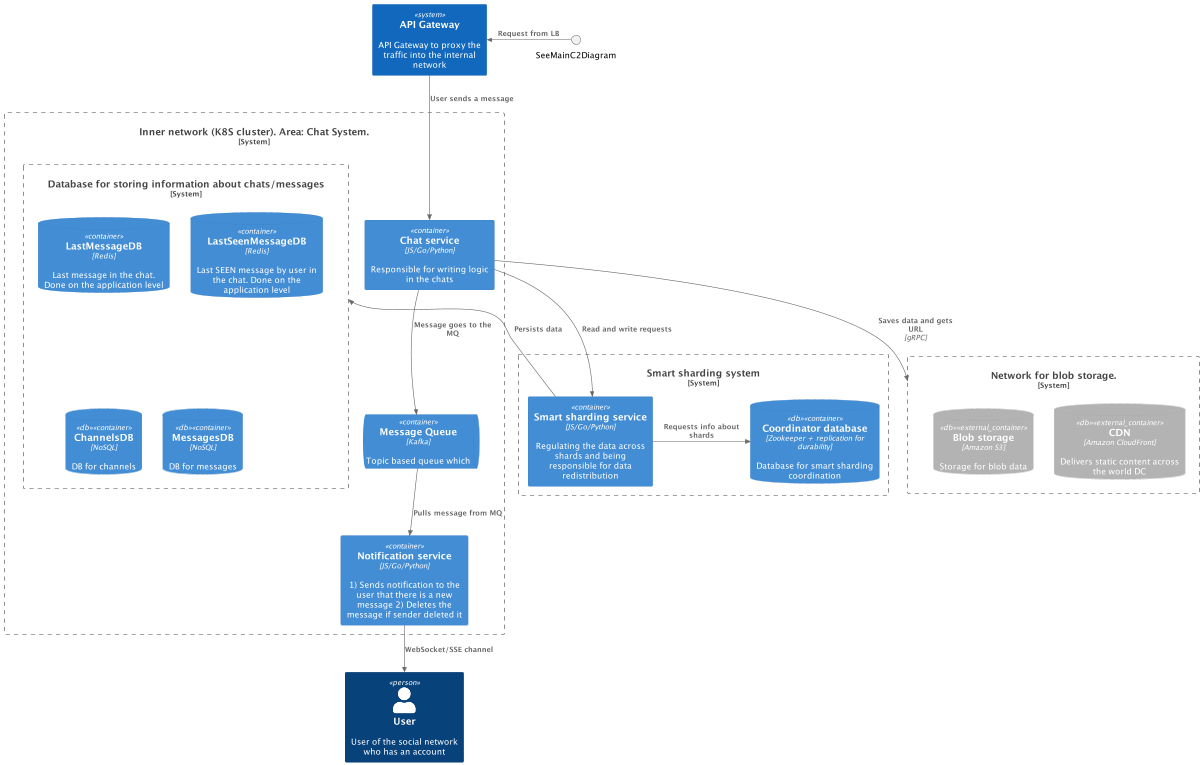Welcome to my personal repository for the System Design course.
This project is dedicated to crafting a robust system design for a social network platform, emphasizing: high-load, fault-tolerance, performance, and scalability.
- View Profile:
- Users can explore profiles by clicking on profile pictures or usernames.
- Discover basic information like names, profile pictures, and friends.
-
Friend List:
- Users can navigate their list of friends.
- Scroll through profiles, view snapshots, and explore connections.
-
Remove Friend:
- Users can unfriend their friends.
-
View Friend Requests:
- Check incoming and outgoing friend requests.
- Approve or decline the requests.
-
Send Friend Request:
- Users can initiate new connections by sending friend requests.
-
Cancel Friend Request:
- Ability to cancel friend requests you've sent.
-
View Feeds:
- Scroll through a dynamic feed of posts from friends.
- Mix of text, images, and shared media.
-
Create Post:
- Users are able to create posts with text and media.
- Posts appear in friends' feeds.
- Max size of a post 4096 symbols
-
Delete Post:
- Users can manage their content by deleting posts when needed.
-
Upload Media:
- Enhance posts by uploading images and media files.
-
Delete Media:
- Users can control media content by deleting uploaded files.
-
View Chats:
- Explore chat history.
- Each chat includes a title (if provided) and the last message sent.
-
Send Messages:
- Communicate with others through text and media messages.
-
Daily Active Users (DAU):
- The system is designed to handle up to 50,000,000 Daily Active Users.
-
Availability:
- The system should maintain an availability of 99.95% to ensure continuous service.
-
Service Operation Time:
- The system is designed to operate seamlessly for a minimum of 5 years.
-
Geo Distribution:
- The system supports users in the Commonwealth of Independent States (CIS) region.
-
Seasonality:
- The system is designed to handle usage patterns without significant seasonality.
- Response Time to View Profile:
- The system aims for a response time of 2 seconds when user opens the profile page.
-
Response Time to Navigate Friend List:
- The system aims for a response time of 1 second when users navigate their friend list.
-
Unfriend Action:
- Unfriending a user should be completed within 2 seconds.
-
Response Time for Approving/Declining Requests:
- Approving or declining friend requests should have a response time of 2 seconds.
-
Send Friend Request:
- Sending a friend request should take no longer than 1 second.
-
Response Time to Scroll Feeds:
- The system aims for a response time of 2 seconds when users scroll through their feeds.
-
Post Creation:
- Creating and posting content should be completed within 4 seconds.
-
Response Time to Upload Media:
- Uploading media files should have a response time of 3 seconds.
-
Media Size Limit:
- Media files are limited to a maximum size of 5 MB to ensure efficient storage and quick download times.
-
Supported Media Types:
- The system supports various media types, including images (JPEG, PNG, GIF).
-
Media Deletion:
- Users can delete media files with a response time of 2 seconds.
-
Response Time to Explore Chat History:
- Exploring chat history should have a response time of 2 seconds.
-
Sending Messages:
- Sending text messages should be completed within 1 second.
- Max size of a message is 1000 symbols
-
Maximum Users in a Chat:
- A chat can accommodate a maximum of 1000 members to maintain effective communication.
I used C4 model to demonstrate my design. I used C1, C2 levels in this architecture as they cover overall architecture and systems
Explanation of this model can be found here
- C1 level
- C2 level. For more details see in-depth architecture of each system below:
-
C2 level per system
-
users:
- posts:
- chats/messages:
- media:
DAU = 50 000 000
Each user reads 20 messages per day
Each user sends 5 messages per day
RPS (read) = 50 000 000 * 20 / 86 400 ~= 11574 r/s
RPS (write) = 50 000 000 * 5 / 86 400 ~= 2894 r/s
Traffic (read per second) = 11574 r/s * (1000 symbols * 2 bytes) ~= 23 mb/s
Traffic (write per second) = 2894 r/s * (1000 symbols * 2 bytes) ~= 6 mb/s
Traffic (read per day) = 2 tb/day
Traffic (write per day) = 518 gb/day
Traffic (read per year) = 730 tb/year
Traffic (write per year) = 189 tb/year
Initial storage capacity for 5 year: 189 tb/year * 5 ~= 1000 tb
Initial storage capacity for 5 years with replication and backups ~= 3 000 tb
For the calculated traffic, it's optimal to use HDD, as it will be sufficient.
The platform traffic: 6mb/s + 23mb/s, HDD (Supports up to 200mb/s).
The size of an HDD disk: 6tb.
The amount of HDD disks required with replicas and backups: 3000tb / 6tb = 500
The amount of HDD disks for one replica: 167
Amount of disk slots on server: 8
Number of shards: 167 / 8 = 21
DAU = 50 000 000
Each user views 10 posts per day
Each user creates 1 post per day
RPS (read): 5787 r/s
RPS (write): 578 r/s
Traffic (read per second) = 5787 r/s * (4096 symbols * 2 bytes) ~= 47 mb/s
Traffic (write per second) = 578 r/s * (4096 symbols * 2 bytes) ~= 5 mb/s
Traffic (read per day) = 4 tb/day
Traffic (write per day) = 432 gb/day
Traffic (read per year) = 1460 tb/year
Traffic (write per year) = 157 tb/year
Initial storage capacity for 5 year: 785 tb
Initial storage capacity for 5 years with replication and backups ~= 2350 tb
For the calculated traffic, it's optimal to use HDD, as it will be sufficient.
The platform traffic: 47mb/s + 5mb/s, HDD (Supports up to 200mb/s).
The size of an HDD disk: 6tb.
The amount of HDD disks required with replicas and backups: 392
The amount of HDD disks for one replica: 130
Amount of disk slots on server: 8
Number of shards: 130 / 8 = 16
